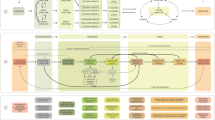Abstract
While ecosystem approaches to management focus on broad spatial scales, decision makers increasingly recognize that implementation must occur at the local level with local land use decisions. This article examines the ability of local comprehensive plans in Florida to incorporate the principles of ecosystem management. It seeks to understand how comprehensive plans can effectively contribute to the management of ecological systems by systematically evaluating local plans against a conceptual model of what makes for a high quality ecosystem plan. Results measure the relative strengths and weaknesses of local plans to achieve the objectives of ecosystem management and provide direction on how communities can improve their environmental frameworks.
Similar content being viewed by others
REFERENCES
Beatley, T. (2000). Preserving Biodiversity: challenges for planners. APA Journal, 66(1), 5-20.
Berke, P., Crawford, J., Dixon, J., & Erickson, N. (1998). Do Co-operative Environmental Management Mandates Produce Good Plans? The New Zealand Experience. Chapel Hill, NC: DCRP.
Berke, P. & French, S. (1994). The Influence of State Planning Mandates on Local Plan Quality. Journal of Planning Education and Research, 13(4), 237-250.
Berke, P., Roenigk, D., Kaiser, E., & Burby, R. (1996). Enhancing Plan Quality: Evaluating the Role of State Planning Mandates for Natural Hazard Mitigation. Journal of Environmental Planning and Management, 39, 79-96.
Burby, R. & May, P., with Berke, P., Dalton, L., French, S., & Kaiser, E. (1997). Making Governments Plan: State Experiments in Managing Land Use. Baltimore, MD: Johns Hopkins University Press.
Cortner, H. & Moote, M. (1999). The Politics of Ecosystem Management. Washington, DC: Island Press.
Cox, J., Kautz, R., Maclaughlin, M., & Gilbert, T. (1994). Closing the Gaps In Florida's Wildlife Habitat Conservation System. Tallahassee, FL: Florida Game and Fresh Water Fish Commission.
Daniels, S., Lawrence, R., & Alig, R. (1996). Decision-Making and Ecosystem-Based Management: Applying the Vroom-Yetton Model to Public Participation Strategy. Environmental Impact Assessment Review, 16, 13-30.
Daniels, S. & Walker, G. (1996). Collaborative Learning: Improving Public Deliberation in Ecosystem-Based Management. Environmental Impact Assessment Review, 16, 71-102.
Duerksen, C. D. Elliot, N., Thompson, E., & Miller, J. (1997). Habitat Protection Planning: Where the Wild Things Are. APA Planning Advisory Report No. 470/471.
Endter-Wada, J., Blahna, D., Krannich, R., & Brunson, M. (1998). A Framework for Understanding Social Science Contributions to Ecosystem Management. Ecological Applications, 8(3), 891-904.
Godschalk, D. R., Beatley, T., Berke, P., Brower, D., & Kaiser, E. (1999). Natural Hazard Mitigation. Washington, D.C.: Island Press.
Grumbine, E. (1994). What Is Ecosystem Management? Conservation Biology, 8(1), 27-38.
Haeubner, R. (1998). Ecosystem management and environmental policy in the United States: Open window or closed door? Landscape and Urban Planning, 40, 221-233.
Holling, C.S., Ed. (1978). Adaptive Environmental Assessment and Management. New York: John Wiley & Sons.
Holling, C.S. (1995). What Barriers? What Bridges? In Lance Gunderson, C.S. Holling, and Stephen S. Light (Eds.), Barriers and Bridges to the Renewal of Ecosystems and Institutions (pp. 3-34). New York: Columbia University Press.
Kaiser, E. J., Godschalk, D. & Chapin, S. (1995). Urban Land Use Planning, 4th ed. Urbana: University of Illinois Press
Kirklin, J. (1995). Protecting Species and Ecosystems Within Planning Processes. Environmental Planning, 12(4), 6-13.
Lee, K. N. (1993). Compass and Gyroscope: Integrating Science and Politics for the Environment. Washington, DC: Island Press.
McGinnis, M., Woolley, J., & Gamman, J. (1999). Bioregional Conflict Resolution: Rebuilding Community in Watershed Planning and Organizing. Environmental Management, 24(1), 1-12.
Noss, R. & Cooperrider, A. (1994). Saving Nature's Legacy: Protecting and Restoring Biodiversity, (Washington, D.C., Island Press).
Noss, R. & Scott, M. (1997). Ecosystem Protection and Restoration: The Core of Ecosystem Management. In M. Boyce and A. Hanley, (Eds.), Ecosystem Management: Applications for Sustainable Forest and Wildlife Resources (pp. 239-264). New Haven: Yale University Press.
Peck, S. (1998). Planning for Biodiversity: Issues and Examples. Washington, D.C.: Island Press.
Randolph, J. & Bauer, M. (1999). Improving Environmental Decision-Making Through Collaborative Methods. Policy Studies Review, 16, 169-191.
Szaro, R., Sexton, W., & Malone, C. (1998). The emergence of ecosystem management as a tool for meeting people's needs and sustaining ecosystems. Landscape and Urban Planning, 40, 1-7.
Wondolleck, J. & Yaffee, S. (2000). Making Collaboration Work: Lessons from Innovation in Natural Resource Management. Washington, D.C.: Island Press.
Yaffee, S., A. Phillips, I. Frentz, P. Hardy, S. Maleki, & Thorpe, B. (1996). Ecosystem Management in the United States: An Assessment of Current Experience. Washington, D.C.: Island Press.
Author information
Authors and Affiliations
Corresponding author
Rights and permissions
About this article
Cite this article
Brody, S.D. Implementing the Principles of Ecosystem Management Through Local Land Use Planning. Population and Environment 24, 511–540 (2003). https://doi.org/10.1023/A:1025078715216
Issue Date:
DOI: https://doi.org/10.1023/A:1025078715216




